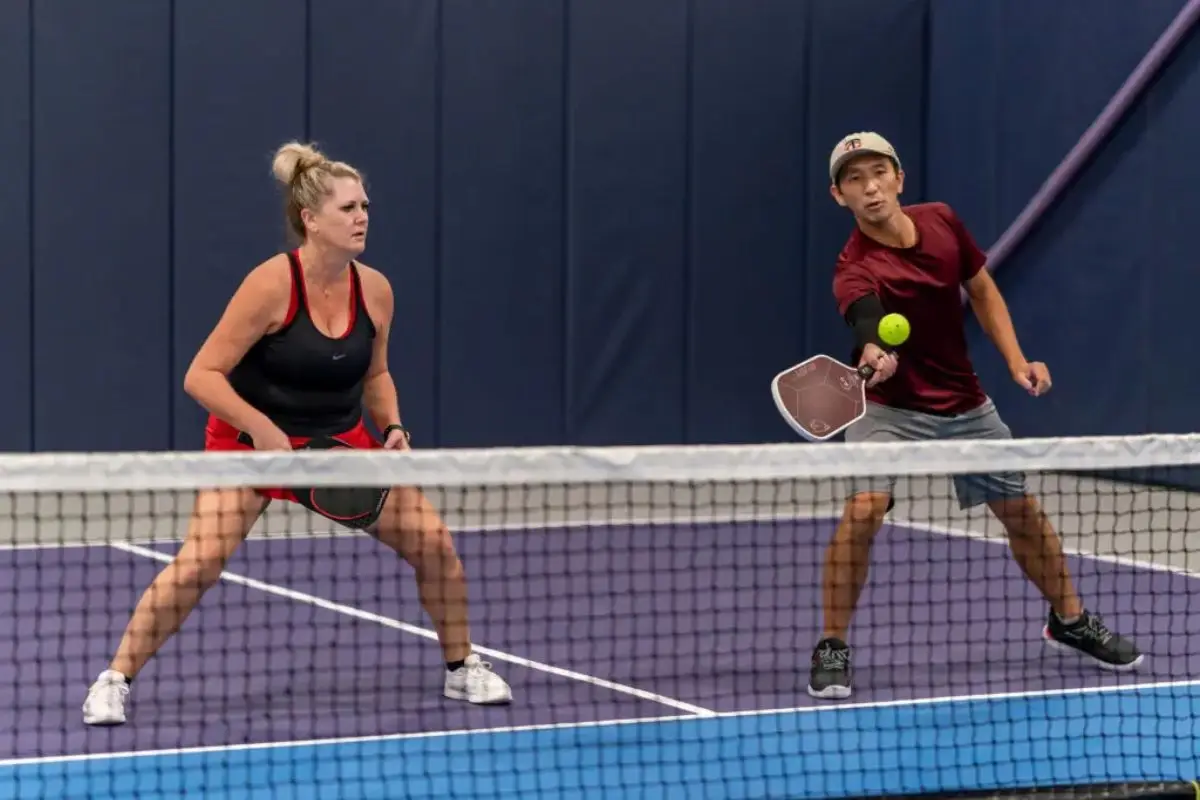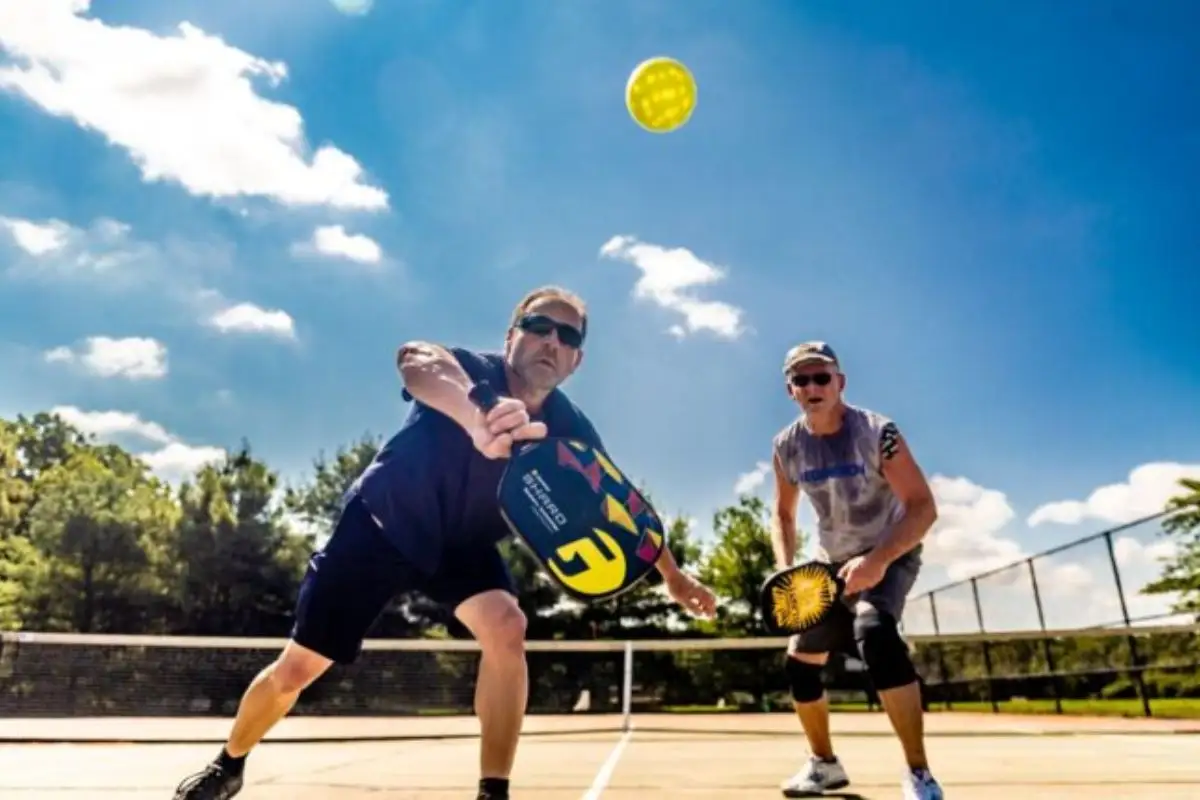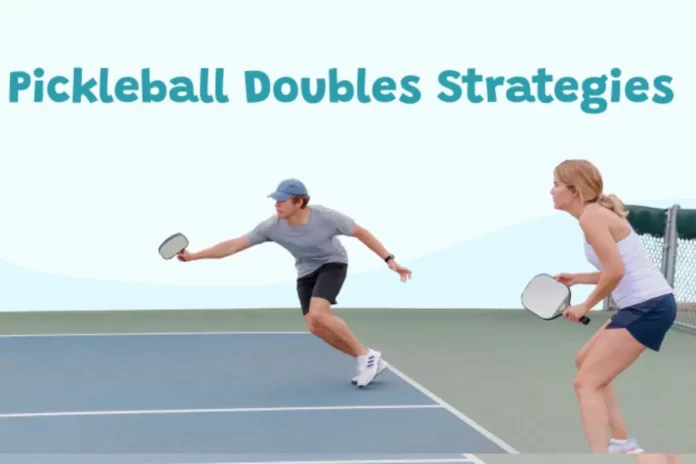10 Must-Know Pickleball Doubles Strategies: Doubles pickleball combines strategy, teamwork, and precise execution. This guide covers the key strategies for improving gameplay, helping players to play on the court with confidence and skill.
1. Serve and Return: Setting the Tone
Effective serving and returning are essential to success in doubles pickleball. The serve should be powerful and deep, ideally near the baseline, to push opponents back and set the stage for an offensive play.
For returns, aiming for the center of the court creates confusion between opponents, forcing them into difficult decisions. Aiming at an opponent’s backhand also maximizes the chances of a weak return, allowing the serving team to control the rally.
2. Dominating the Kitchen: The Key to Offensive Play
The non-volley zone, commonly referred to as the kitchen, is a critical area to control in doubles pickleball. Gaining access to this zone early after the serve can help the team dominate the net and force opponents into defensive positions.
Once at the kitchen line, keeping shots low is crucial. Dinking—the technique of hitting the ball softly and just over the net—requires precision but allows the team to dictate the pace of the game. This soft play forces opponents to react quickly and makes it harder for them to execute powerful shots.
3. Team Coordination: Movement and Communication
Effective teamwork in doubles pickleball requires clear communication and seamless movement. Partners should always work in unison to cover the court, avoiding gaps that can be exploited by the opponents.
Communication should be direct and quick, using simple phrases like “mine” or “yours” to claim the ball. This minimizes confusion and ensures that each player knows who is responsible for each shot. Additionally, both players must constantly adjust their positions based on where the ball is, ensuring that the entire court is always covered.

4. The Third Shot Drop: A Game-Changer
The third shot drop is a hallmark of high-level doubles pickleball. After the serve and return, the third shot should ideally land softly in the opponent’s kitchen, putting them on the defensive and setting up the team to advance to the net.
If a third shot drop is not possible, opting for a deep drive down the middle of the court forces opponents into an awkward position, preventing them from making an aggressive return. A well-executed third shot is a crucial strategy for controlling the flow of the game.
5. Targeting Weaknesses: Exploiting Opponent Vulnerabilities
Successful doubles teams must always be aware of their opponents’ weaknesses. Targeting an opponent’s backhand or a less-skilled player is a smart way to increase the likelihood of errors.
Pushing opponents toward the baseline with deep shots can also force them out of position, allowing the team to move in and take control of the net. Recognizing and exploiting these weaknesses provides a significant advantage.
6. Reducing Errors: Focus on Consistency
Minimizing unforced errors is essential for a winning strategy. Rather than attempting flashy or risky shots, players should focus on consistent, well-placed shots that keep the rally going and force opponents to make mistakes.
For example, executing a simple, controlled drop shot can be more effective than going for a powerful overhead smash, especially if the latter has a low probability of success.
7. The Art of Dinking: Precision Over Power
Dinking is a vital skill for doubles pickleball. It requires precision and control, as players must keep the ball just over the net and within the kitchen. A well-placed dink can disrupt an opponent’s rhythm, forcing them into uncomfortable positions.
When dinking, it’s important to aim at an opponent’s backhand or feet, as these are the more difficult areas to return from. Patience is key—dinking creates opportunities for opponents to make mistakes, which can lead to easy points.
8. Diversifying Shot Choices: Keep the Opponents Guessing
Varying the types of shots can prevent opponents from settling into a comfortable rhythm. Changing from a soft dink to a fast drive, or following a series of controlled shots with a sudden lob, keeps opponents on edge.
Switching up the pace of shots—alternating between slow, controlled dinks and quick, aggressive drives—forces opponents to adjust their positioning and reaction time, making it harder for them to anticipate the next move.

9. Staying Calm and Adaptable: Mental Toughness
Mental resilience is just as important as physical skill in doubles pickleball. Staying calm after mistakes and maintaining focus is key to long-term success.
Flexibility and adaptability are also crucial. If a team’s initial strategy isn’t working, switching to a different approach—such as playing more defensively or shifting to a deeper shot—can help overcome tougher opponents. Staying mentally sharp allows players to adjust and stay competitive, regardless of the situation.
10. Playing Smarter, Not Harder
Powerful shots are often seen as an asset, but in doubles pickleball, it’s often more effective to rely on placement and strategy rather than sheer force. Well-placed shots that exploit gaps in the court or target weaker areas of an opponent’s game are more likely to win points than high-powered but poorly executed attempts.
Mastering placement over power ensures that a team can control the tempo of the match and wait for the right moment to strike. Precision and patience win games over brute strength and force.
Achieving Success in Doubles Pickleball
By focusing on strategy, communication, and teamwork, players can elevate their doubles pickleball game to new heights. Mastering key tactics like controlling the kitchen, targeting weaknesses, and playing consistently allows teams to outsmart even the toughest opponents. With practice and a commitment to improvement, players can enjoy long-term success on the court.
News in Brief: 10 Must-Know Pickleball Doubles Strategies
Effective doubles pickleball requires teamwork, strategy, and communication. Key tactics include mastering the serve and return, controlling the kitchen, and using the third shot drop to neutralize opponents. Players should focus on exploiting weaknesses, keeping shots consistent, and avoiding unforced errors.
Dinking with precision and varying shot selection can disrupt the opponent’s rhythm, while staying adaptable and calm is essential for overcoming challenges. With practice, these strategies help teams dominate and achieve success on the court.
ALSO READ: How to Take Control of the Net and Win More Points in Pickleball

